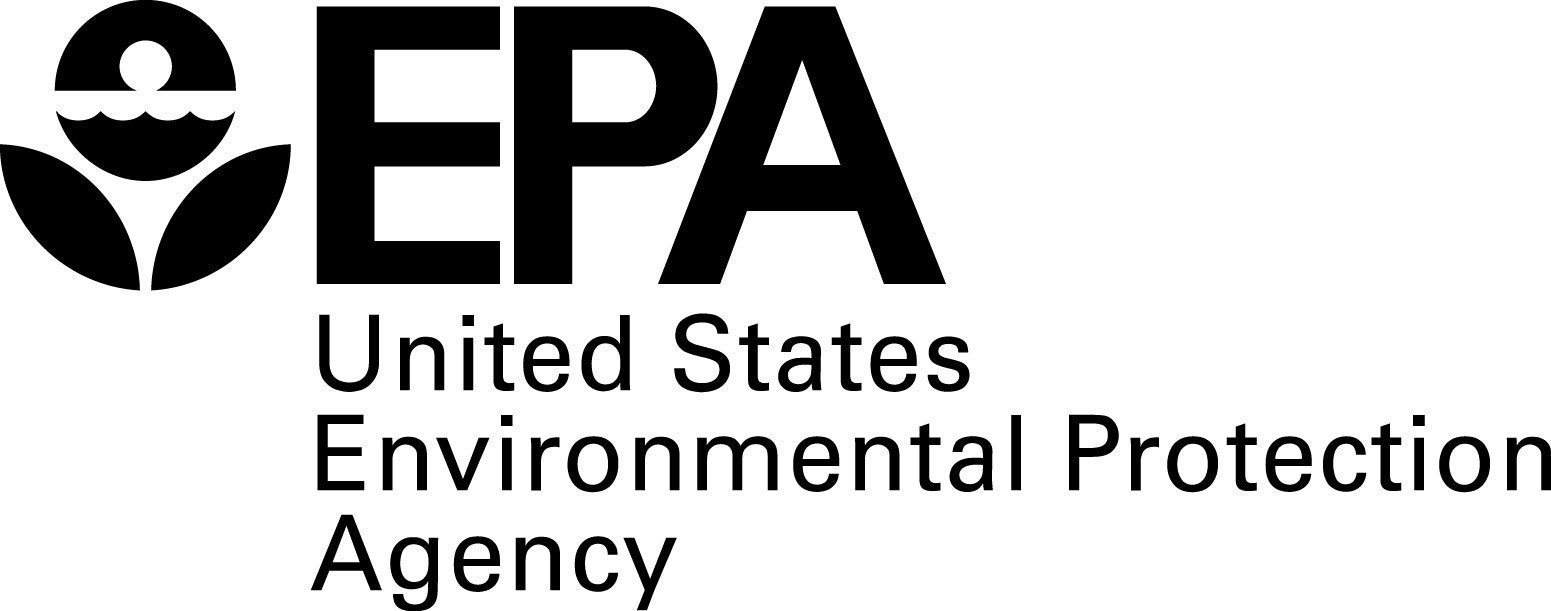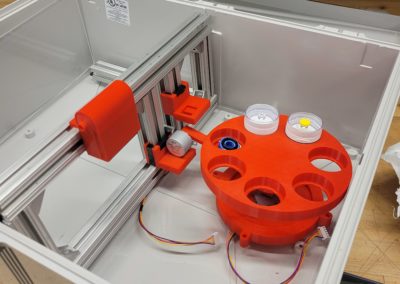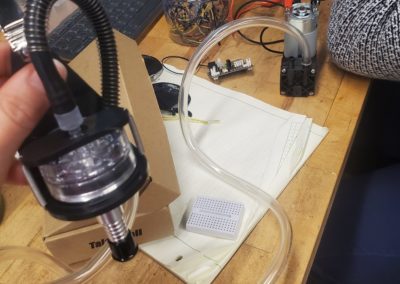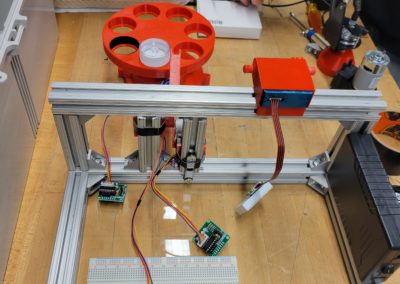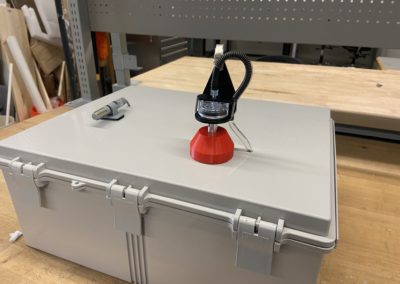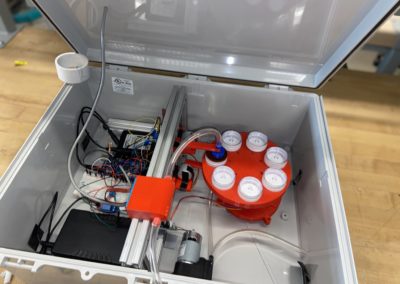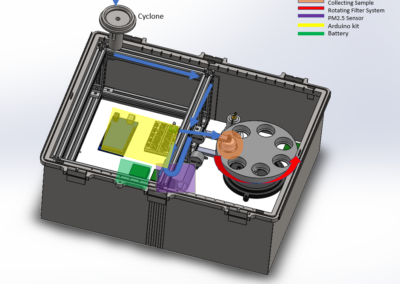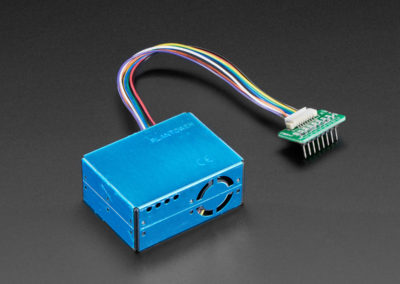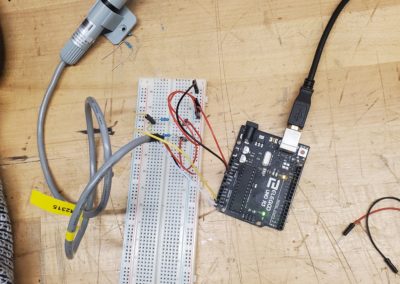Air Quality Sampler
Overview

Throughout the history of Smeltertown, Colorado, three different companies have impacted the region by releasing byproducts such as molten slag, creosote, hydrogen sulfide and acid mist emissions that affected the soil, water, and air quality of the nearby town of Salida, Colorado. The Smeltertown Super Fund cleanup operation was conducted between 1993 and 2003 by the Environmental Protection Agency (EPA). Since the Smeltertown site’s removal from the Super Fund List, the site still requires long-term monitoring to ensure the remedial action that took place was effective. Therefore, inspections of the site contamination occur every five years. For this reason, the EPA is interested in an air quality sampler that meets the following constraints: (1) is light weight, (2) is easy to travel with/ compact, (3) has a battery life of at least two weeks, (4) can collect multiple samples, and (5) can detect PM10 and PM2.5 particle sizes. The primary objective of this project is to meet these goals while keeping overall costs of production below $500.
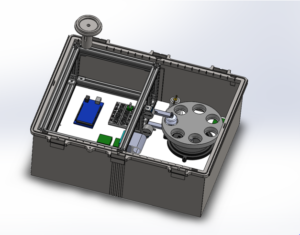
Air Quality Sampler Design
The team’s design incorporates a cyclone-pump collection system that pulls air through a PM2.5 sensor while reporting real time PM2.5 concentrations to a USB port on Arduino. If the PM2.5 concentration reaches a set maximum, the rotating filter holder places a filter in line with the tubing to collect dust samples to be taken to a lab for further analysis. The rotating filter holder can carry six filters at a time for sampling while leaving one slot empty to allow air to move through the sampler when the PM2.5 concentration is below the set maximum. The design also features a humidity sensor that runs separately to provided humidity data for each sample taken to the lab.
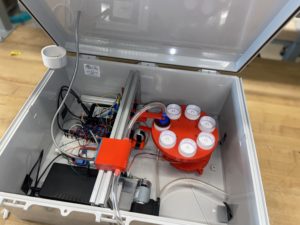
Air Quality Sampler Prototype
Live Zoom Chat
Use the link below to join us live from 8:00 – 10:30 a.m. on April 29th.
Telephone:
Dial: +1 253 215 8782 (US) or
+1 346 248 7799 (US)
Meeting ID:
857 1033 8343
Team Members
- Abdul Nasser Al-azri
- Stefan Handlos-Fruhwirth
- John Mateer Hudgens
- Giovanna Mendoza
- Alexander Plate
The Client
- Erna Waterman, EPA
Acknowledgements
Client: Erna Waterman, (EPA)
Project Advisor: Prof. Lisa Woodward (Mines)
Technical Advisors: Michael Hoppe (EPA), Michelle Kerr (EPA), Phillip Romig III (Mines)
Last Year’s Team: Andrew Clexton (Mines Alumni)
Video
Elevator Pitch
The Smeltertown Superfund cleanup operation was conducted between 1993 and 2003 by the EPA to address the soil and air contamination from past manufacturing operations on this property. The EPA and Colorado Department of Public Health and the Environment (CDPHE) inspect the Smeltertown Site every five years. In addition, air monitoring is important to local health departments to address concerns from their residents as poor air quality can cause serious health problems.
The EPA has asked our multidiscipline Capstone Design@Mines team, Dust Busters, to design and test a new air quality sampler for PM2.5 that can be easily transported across the country as a carry-on by plane for other sites of similar concern. Our air quality sampler is unique as it uses a cyclone collection-based design with real time PM2.5 data output, as well as a filter collection system so collected dust can be taken to a lab for further analysis. The air quality sampler also features a humidity sensor and temperature control carrying case to help the sampler operate in a broader range of climates.
Design Approach
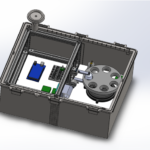
(1) Air Quality Sampler
After discussing with stakeholders, the team has decided to take elements of existing air quality samplers in current use and make modifications to build an air quality sampler prototype. The air quality sampler (Picture 1) will rely on a cyclone design that will be used to collect air samples into a rotating filter holder that can store at least seven samples. In addition, there will be a PM2.5 sensor that will be able to collect data into a flash drive to analyze particulate density throughout the day. This design will also allow for minimal human interaction through the sampling period but will require setup and proper procedures in transporting samples to a lab for further analysis.
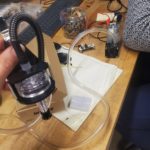
(2) Cyclone attached to pump.
The reason a cyclone (Picture 2) will be implemented is that it is an effective air current manipulator; it requires minimal maintenance; it has a low relative cost; it can operate at elevated temperatures; and it can handle liquid mist or dry materials. However, the cyclone has a low efficiency for smaller particulates, and the pressure drop must be considered. This was resolved through proper scaling of the cyclone in comparison to the size of the sampling box and the inflow rate required to transport dust particles into the filter collection system.
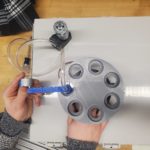
(3) Rotating Filter Holder
The design differs from current air quality samplers in that it will be able to store multiple samples using a rotating filter holder (Picture 3) and thus allow continuous sampling over a longer period. The rotating filter holder design may increase the size and weight of the sampler since integrating the moving parts adds complexity and will require more power. To address this, a long-lasting battery will need to be implemented. The battery must also be as light weight as possible since most of the weight comes from the power source.
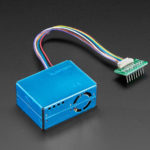
(4) pms5003 PM2.5 Sensor
A PM2.5 sensor (Picture 4) will be included because it will provide information on the particulate sizes and particulate density through time of the site to analyze patterns and behaviors of the site. The sampler will be transported in a single weatherproof case that can be easily set up carried by an individual.
Design Solution
Our final design features a cyclone-pump collection system with a stock collection efficiency of 99.98%. These are connected by static plastic tubing so dust particles do not accumulate throughout the tubing. This tubing then runs through a PM2.5 sensor which is connected to an Arduino board that is producing live PM2.5 data accessible via USB. If the PM2.5 concentration exceeds a certain limit, the rotating filter rack is activated and turns to an unused filter. The rotating filter holder can hold up to 6 filters for sample collection. This leaves one slot on the rotating rack empty for when the sample is continuously monitoring. The stepper motors will remove the tubing while the rack rotates and reconnect when the next slot is in position. After a sample is taken, the rack will rotate back to the empty slot. The entire system runs on 72-Watt hour batteries that provided up to 5.5 hours of continuous power and can be recharged between sampling times and locations.
To Summarize:
- Cyclone-Pump collection system
- PM2.5 Sensor
- USB module for data retrieval
- Stepper Motor Filter and Tube adapters
- Rotating Filter Holder Rack
- Accommodates up to six samples and one slot for continuous flow
- 72-Watt hour capacity batteries
- Rechargeable
- 5.5-hour continuous power supply per battery
Next Steps
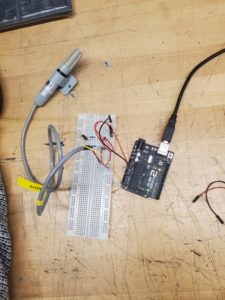
Humidity Sensor running separately from rest of the sampler.
Our team was successful in testing each subsystem individually as well as collecting PM2.5 data while the cyclone, pump, and rotating filter operated. The PM2.5 data can be plotted against time to visualize PM2.5 concentrations. Better organization of the PM2.5 data is necessary for longer exposure times in the field.
For future work, the client can decide how to integrate each component so the sampler can run autonomously for 20 hours at a time. Our group used Arduino for basic data results, but recommend exploring other interfaces to connect the sensors, pump, cyclone, filter rack rotations, and data output. If the client decides to push the project into a 3rd generation, we recommend having a computer science major on the next team to help with integrating the design code.
The client can also look into testing different tubing materials and adapters to ensure no air flow is lost from the system so accurate calculations can be made. The air flow has to work in accordance with the cyclone and pump to ensure dust particles are not accidentally propelled too quickly or slowly into the filter collection rack.
Since the sampler will be transported across the country, physical trials of the case and rotating collection system against turbulence or impacts should be tested for the sampler’s internal integrity. This includes drop testing, transportation, and potential water or humidity damage. The client can then look into writing a guidebook for EPA field agents to deploy, operate, and repair the sampler in the field based on common malfunctions throughout physical testing.
Meet the Team
Abdul Nasser Al-azri
 Civil Engineering Lead
Civil Engineering Lead
Stefan Handlos-Fruhwirth
 Communication Lead
Communication Lead
I am a senior earning a Bachelor of Science in Environmental Engineering in pursuit of a career in sustainable design practices and water reclamation and reuse. I will be graduating in the fall and looking for research while studying for the Fundamentals of Engineering exam in the following spring.
John Mateer Hudgens
 Scrum Master
Scrum Master
Hello, my name is John Mateer Hudgens and I am a graduating senior majoring in Civil Engineering. I am interested in working in the public sector in water resources or hydrology either back home in Austin, Texas, or here in Colorado.
Giovanna Mendoza
 Environmental Lead
Environmental Lead
My name is Giovanna Mendoza and I am graduating this May (2021) with my degree in Environmental Engineering. My parents immigrated from Mexico to the United States in order to give my siblings and I opportunities that we would not have otherwise. I grew up in a low income household with a single mom. Growing up, circumstances required me to grow up quickly and learn a lot of valuable skills. Due to challenges and opportunities that I have had, I discovered my passion has always been focused in the STEM field. I applied to Colorado School of Mines because I knew I wanted to be an engineer, but I also wanted to be a role model to other youth that had a similar background as myself. In high school I had the opportunity to intern at the Denver Museum of Nature and Science as a Teen Science Scholar. My focus was on the paleontology program and quickly found out I had a love for field work. This is why when I entered college, I originally was a petroleum engineering student before changing my major to environmental engineering. I changed my major because I realized that the field work I wanted to focus on was the sustainable aspect of environmental engineering. I liked the ingenuity of new technologies as well as the aesthetic of making something beautiful, yet practical. I am still seeking employment in jobs that focus on sustainability or as a consultant.
Alexander Plate
 Mechanical Lead
Mechanical Lead
I will be graduating in May with a Bachelor of Science degree in Mechanical Engineering and I am looking forward to taking the FE certification in pursuit of a career in Mechanical Design and Manufacturing.
